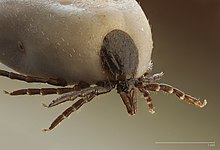 Global Information
Global InformationTick information
| Tick Temporal range: Albian to present
| |
|---|---|

| |
| Ixodes ricinus, a hard tick | |
| Scientific classification | |
| Domain: | Eukaryota |
| Kingdom: | Animalia |
| Phylum: | Arthropoda |
| Subphylum: | Chelicerata |
| Class: | Arachnida |
| Superorder: | Parasitiformes |
| Order: | Ixodida |
| Superfamily: | Ixodoidea Leach, 1815 |
| Families | |
| |
| Diversity | |
| 18 genera, about 900 species | |
Ticks are parasitic arachnids of the order Ixodida. They are part of the mite superorder Parasitiformes. Adult ticks are approximately 3 to 5 mm in length depending on age, sex, species, and "fullness". Ticks are external parasites, living by feeding on the blood of mammals, birds, and sometimes reptiles and amphibians. The timing of the origin of ticks is uncertain, though the oldest known tick fossils are from the Cretaceous period, around 100 million years old. Ticks are widely distributed around the world, especially in warm, humid climates.
Ticks belong to two major families, the Ixodidae or hard ticks, and the Argasidae, or soft ticks. Nuttalliella, a genus of tick from southern Africa, is the only member of the family Nuttalliellidae, and represents the most primitive living lineage of ticks. Adults have ovoid/pear-shaped bodies (idiosomas) which become engorged with blood when they feed, and eight legs. Their cephalothorax and abdomen are completely fused. In addition to having a hard shield on their dorsal surfaces, known as the scutum, hard ticks have a beak-like structure at the front containing the mouthparts, whereas soft ticks have their mouthparts on the underside of their bodies. Ticks locate potential hosts by sensing odor, body heat, moisture, and/or vibrations in the environment.[1]
Ticks have four stages to their life cycle, namely egg, larva, nymph, and adult. Ticks belonging to the Ixodidae family undergo either a one-host, two-host, or three-host life cycle.[2] Argasid ticks have up to seven nymphal stages (instars), each one requiring blood ingestion, and as such, Argasid ticks undergo a multihost life cycle. Because of their hematophagous (blood-ingesting) diets, ticks act as vectors of many serious diseases that affect humans and other animals.
- ^ "How ticks spread disease". Centers for Disease Control and Prevention. 21 September 2020. Retrieved 29 November 2020.
- ^ "Ticks". CDC - DPDx. 23 January 2019. Retrieved 29 November 2020.